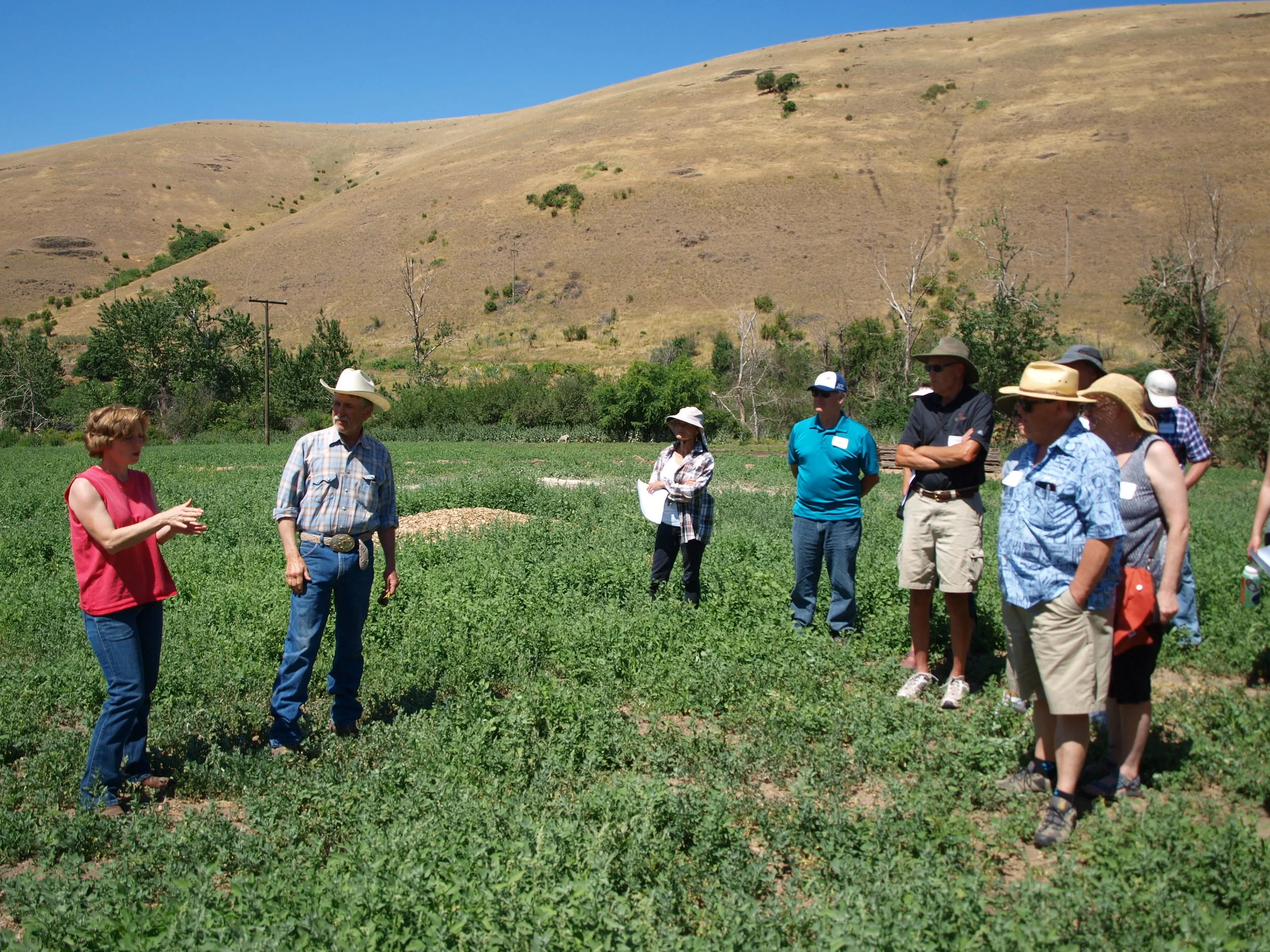Alfred Diaz, Walla Walla Union Bulletin July 25, 2017
The following article reports on a portion of “Sacred Cows,” our July 8 Learning on the Land event that explored holistic pasture management.
The event was in two parts. First, we viewed the short film “Soil Carbon Cowboys,” and then enjoyed a talk by Andrea Malmberg, the former director of education of the Savory Foundation. Andrea discussed the impacts of traditional grazing practices and the benefits of a new approach that mimics natural processes. Second, we visited Cheryl and Robert Cosner’s Upper Dry Creek ranch.
Reporter Alfred Diaz of the Walla Walla Union Bulletin caught up with us at the Cosners’ ranch and picked up the story from there.
WESTON – They might be described as a minority of down-to-earth farmers who are trying to spread the word over a common ground they share in livestock ranching – in particular a grazing method some say would be far friendlier to the planet and its atmosphere.
“You have to get down on your hands and knees and see what is going on in the soil,” said Cheryl Cosner of Upper Dry Creek Ranch just outside of Weston in Umatilla County.
What has her up-close and personal with dirt?
A livestock ranching technique that emphasizes a variety of holistic farming relationships between people, animals, plants, and especially, the soil. And all these combined relationships are deeply rooted in a livestock ranching practice called “controlled grazing.”
According to a July article by the Washington State University Walla Walla County Extension Office, controlled grazing limits livestock access to pastures by using paddocks or temporary enclosures to create an intense rotational grazing system.
When properly used, the article stated, controlled grazing can increase and improve ground forage, extend grazing seasons, reduce the need for fertilizers and herbicides, produce fewer weeds, reduce labor and promote environmentally responsible grazing areas.
Ask Allan Savory – probably the most notable champion of controlled grazing — and the ecologist would add one more key benefit. And it’s a big one: the end of global warming.
An 81-year-old Rhodesian livestock farmer and environmental activist who is rooted in grasslands, Savory once espoused the complete opposite of controlled grazing – which would be no grazing and the removal of livestock from sensitive grasslands.
And at one time in the late 1960s, he even promoted the destruction of roughly 40,000 African elephants to save critical grasslands and stop desertification. It was a failure, Savory noted in a 2013 TED Talk (ubne.ws/2uHborv), and one of the main reasons he would take a 180-degree turn in the latter part of his life.
The new theory Savory now promotes is one that uses large numbers of herding livestock in close quarters for short periods – mimicking natural grazing by animals such as American bison when they traveled in massive, compacted herds in the Old West.
If this technique were applied to the unusable or barren grasslands of the world – including lands no longer usable because of constant overgrazing – Savory asserts the result would be a reduction in atmospheric carbon to levels prior to the Industrial Revolution.
But it should be noted that many environmentalists have highly criticized Savory’s research and claims. And the opponents far outnumber the supporters of controlled grazing.
Proof is in the pasture
But for Cosner and her husband, Robert, the proof is in the results at Upper Dry Creek Ranch.
Cosner isn’t ready to take on global warming, but she will back up controlled grazing and other holistic methods with the lush pastures seen on her farm, as well as profits. And during a recent Blue Mountain Land Trust tour of the Cosner farm, the couple spoke of the success they have seen since taking over the unproductive land in 2004 and turning it into nourishing paddocks for their 2,200 sheep and cattle.
“These principles apply to everybody, but everybody’s situation is different,” Cheryl Cosner said. “Every farm is different. And there are variables.”
What kind of variables?
Take their current main paddock, which is overgrown with lamb’s quarters, a weedy annual. Usually, the 6-acre section would have already been grazed down by late May, which would then be followed with a recovery period as grasses grew throughout the summer. But late rains this year brought on a thick growth of lamb’s quarters. So earlier this month the Cosners made plans to bring in their sheep because that’s what sheep like to eat.
It’s all about holistic planning – adapting for the unpredictable and knowing your resources, Cosner added.
First, there are the goats, who eat about everything from nose height up. Second, there are the sheep, who like to eat broadleaf plants and other tap rooting species. Then there are what Cosner called the lawn mowers – the cattle.
“We don’t see any species of plant that is being a problem species, unless nothing eats it,” Cosner said. “And we always seem to have something that will eat it.”
Holistic ranching
Across the mountains in Oregon’s Grande Ronde Valley, Tony Malmberg uses a very similar holistic approach that includes controlled grazing for his cattle ranch.
Like the Cosners, Malmberg is adaptable. And sometimes being adaptable can even help deal with pests.
When Malmberg started controlled grazing, he used to run cattle in a paddock for half the year. The Elgin rancher said he soon saw the benefits to his pastures by reducing that period to 30 days. More recently, he reduced that grazing period to 10 days because of horn fly pests.
It turns out the horn fly has a life cycle of 10 days. And if Malmberg moves his cattle before it begins, he doesn’t have to deal with the flies, and that saves him money and gives him healthier cattle. This system of prevention is one that he said ranchers haven’t always used.
“Our ranching culture is really good at putting out fires but we are not good at preventing fires,” Malmberg added.
A Wyoming cattleman most of his life, he said open range ranching is how he did it when he started. The cattle were allowed to roam over a large tract of land. And problems such as horn flies were handled as needed, usually by applying costly herbicides, fertilizers and medicines.
“The holistic managing planning process prevents those fires,” Malmberg added.
Like night and day
So why does controlled grazing work for Malmberg and Cosner?
Savory and other supporters of controlled grazing suggest that in tight quarters livestock feel as though they have more competition, and thus eat everything. But when free ranging over vast tracts of land, livestock tend to eat what they like and leave the rest of the unwanted plants alone to thrive.
Other studies show that livestock manure, urine and even their saliva promote healthy soil and desired plant and insect growth.
Savory adds that the ground also benefits from the breaking up of the crust by animal hoofs, allowing the ground to absorb more moisture rather than letting it evaporate or run off. And he notes numerous success stories, where desertified or near-barren land has been returned to lush pastures after controlled grazing was applied.
And even though there are critics, Tim Copeland of the Blue Mountain Land Trust said it is hard to ignore the positive results the Cosners and Malmberg have experienced.
“When we got (to Malmberg’s ranch), the grass was really luxuriant. The cattle were feeding in quite a controlled area of the pasture,” Copeland said.
Then he also inspected the adjacent Conservation Reserve Program land, which is land set aside by the U.S. Department of Agriculture for the promotion of native plant species.
“Here is (Malmberg’s) grass, and he is grazing it,” Copeland said, using his hands to show a length of almost 2 feet.
He then moved his hands a few inches apart.
“And here is the ungrazed grass that they are leaving alone, and have been for many years,” he said, “and it is very short and very brittle and has significantly more weeds. It was a night-and-day comparison.”

